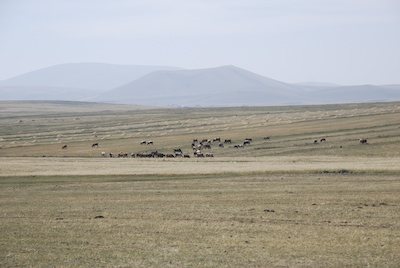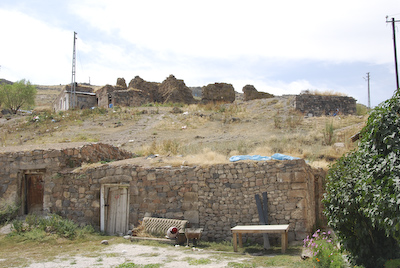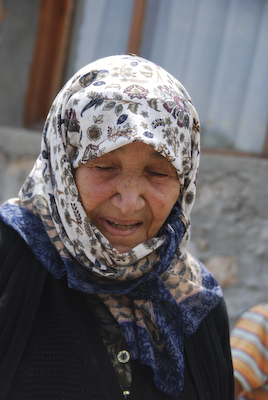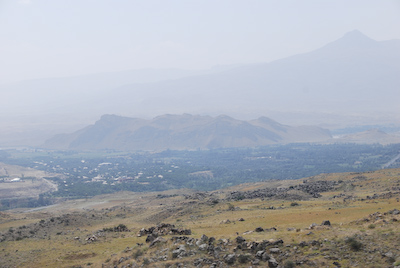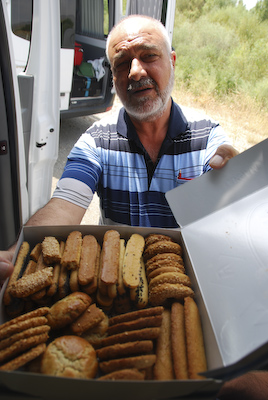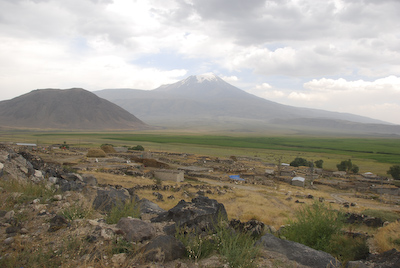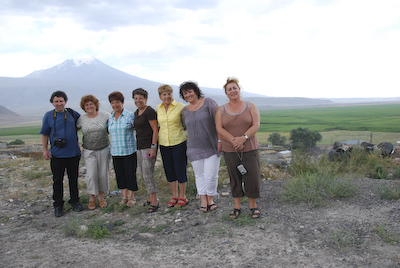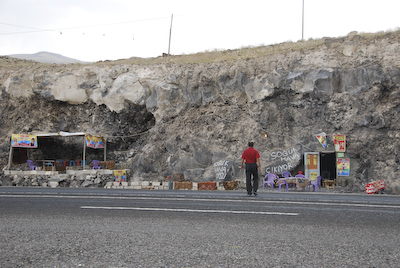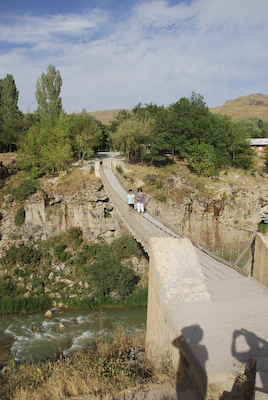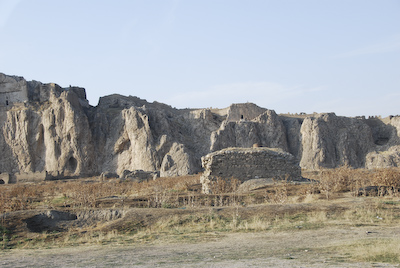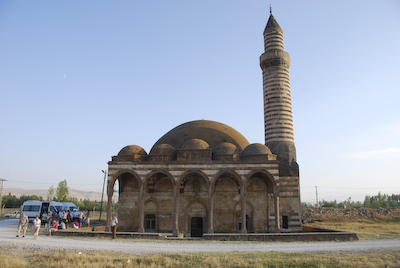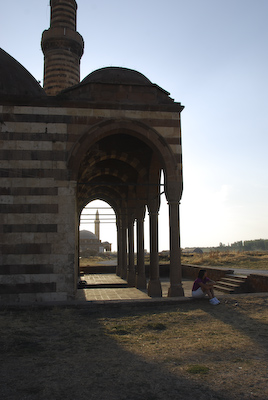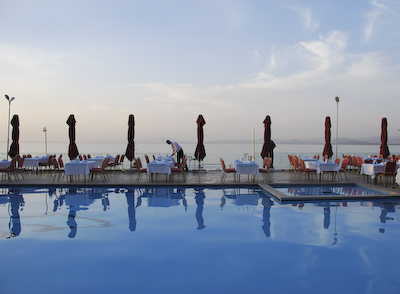August 18th Wednesday The weather was sunny and hot; a thunderstorm at dusk
The highway between Kars and Van runs directly south and it is a long day’s drive to the city of Van. Kars is located in the north eastern part of Turkey close to the borders of Georgia and Armenia. Trains and buses run regularly across the Georgian border to Tsibili and we saw signs pointing toward the frontier. For now, the border between Armenia and Turkey is closed and there is absolutely no transportation between the two countries.
We pulled off the road and into a small village, named Digor. It used to be an Armenian village and there are supposed to be the ruins of five Armenian churches in the area. We drove through the center of the village and stopped in front of an old woman’s house. Behind her house is the ruins of an Armenian church.
The woman spoke to Setanik in Turkish and said that she was 82 years old and has lived in the house since she was a child and that the church had been in ruins all her life. However, her mother told her that her grandmother prayed in the church many years ago.
Many Armenian women were forced to marry Turkish men and raise their children as Muslims. The woman raised 10 children in the house is a grandmother and great-grandmother. There were several younger women nearby and a few children were playing near the house. She smiled and seemed to enjoy talking to Setanik.
Older boys gathered by the van and talked to Chris. They told him about more churches in the region and wanted to show us where they were. Since we didn’t have the time to follow the young boys, we got back into the van and drove slowly back through the village. A man waved at the van and Celcuk stopped to inquire. The man said that another man had pictures of the church. We waited a few minutes and a man appeared with two old photographs of Armenian churches.
He proudly showed them to us. He did not want to sell the photos to us, but was talking about them in Turkish. Unfortunately, we could not understand what he said and the usual crowd of men gathered around us to find out what was going on. Meanwhile, Chris got off the van and went into the barber shop on the corner. We laughed about him getting a haircut, but we had to go and someone ran to call him.
The terrain became more rocky and mountainous, the farther east we traveled. Someone said that there was an old folktale about a man who had a dream that rocks were thrown from the heavens and that rocky place became Armenia. Another suggestion was that when Turkey and Russia divided the land after World War I, the Turks took the better, more fertile fields for themselves and gave the less desirable land to the Soviet Armenians.
Jemal Offering Turkish Cookies
During the long drive we entertained ourselves during the long ride by singing French songs, listening to Selcuk’s Turkish music CDs, dancing in the aisle of the van, and telling stories. Satenik passed the microphone back to Nicole and Francoise and they led us in a French & English song-fest. Selchuk was even inspired to sing a beautiful song in Turkish. He had a great collection of music CDs from many cultures: Kurdish, Persian, Turkish, and Armenian. The music from the countries is similar “Middle Eastern” music to my ear, but Selcuk says each country’s music is different. We enjoyed driving through the rough countryside listening to Middle Eastern/Turkish music.
We stopped a few times along the road to take photos of interesting sights. We were all looking forward to our first glimpse of Mt. Ararat, which is the national and spiritual symbol of Armenia. The famous mountain is now located on the Turkish side of the Armenia/Turkey border, and both countries claim the mountain as their own.
Mt. Ararat is supposed to be the traditional resting place of the biblical Noah’s Ark after the 40-day flood. Perpetual snow and cold near the peak keep people from uncovering the Ark and over the years, various groups have explored the mountain in the hopes of finding the remains of Noah’s Ark.
The summit of Mt. Ararat is 16,946 feet above sea level. It is a dormant volcano and its last eruption was June 2, 1840. Along the sides of the road there were large black rocks probably volcanic stones. The upper third of the mountain is covered with snow and ice throughout the year. Adjoining Mt. Ararat (4000 ft. lower) is the peak known as Little Ararat. The first recorded ascent was in 1829. While we were staying at the hotel in Van, we met a man who was part of an expedition to climb the mountain that week.
Across the road from the place where people stop to take photos of Mr. Ararat, was an outdoor “tea shop” which was set up by an enterprising Kurdish family. Chai, as it’s called in Turkey, is the very popular drink of choice any time of the day or night. Several members of our party stopped to have chai along the road. It was raining and it seemed to be a good time and place to stop for a break.
We drove on toward Van and after a while, took another break near a beautiful waterfall. It seemed to be a family rest-stop with a snack bar near the parking lot. There was also a large rustic restaurant on the other side of a rope bridge spanning the gorge.
The WCs were a bit of a walk behind the restaurant. The young man sitting between the men’s and women’s sections was asking for one Turkish lire to use the facilities, instead of the customary .50 which was typical everywhere else in Turkey. We commented on his enterprising nature.
Before we entered the city of Van, we drove to a large natural rock formation which is located about 3 kilometers from the center of the city of Van and Selcuk parked the van. It is called Van Castle or the Rock of Van which dominates the view of the city. The van was parked near the ruins of the old city which was destroyed in 1915. A few buildings have survived and there is a stone mosque near the parking lot.
This had been a sacred place to the ancient Urartu people who carved out burial caves high up into the rocks. Armenians are descendants of the ancient Urartu, so many people believe that this land rightfully belongs to the Armenian people. There are supposed to be numerous ‘khachkars” (Armenian stone crosses) carved into the southern side of the rock.
The sun was setting and it cast a beautiful light on the stones. The mosque near the parking lot glowed in the golden light. We walked around a little and watched families carrying plastic bottles of water. We wondered if there was a spring nearby.
It was getting late and we all got into our vans and drove to the Hotel Merit right on the shore of Lake Van. It was a large modern looking stone building with a large lobby and seating area on the ground floor. Through the glass doors past the reception desk is a large inground pool with tables set around the pool. The pool area is right along the lake shore. At the right angle it looks like the pool continues into the Lake Van.
We received our room assignments, took our luggage up to our rooms and reconviened by the pool for dinner. There was a large tent-like structure to the right of the pool and this was a buffet area set up with all the food in a semi-circle of tables along the outer edge of the room. On the left were many choices of appetizers or mezes as they’re called in turkish. Then the many choices of meats and vegetables, both hot and cold, and then the desserts and finally the chai area. Everything looked delicious.
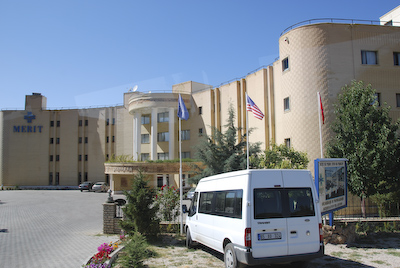 Entrance to the Merit Hotel on Van Lake
Entrance to the Merit Hotel on Van Lake
The main problem was that there were many little gnats hopping around the tables by the pool and I could not sit there or bring food to the table. I suggested taking the dish into the lobby and eating there. The manager moved us away from the pool and those tables were better so we could eat.
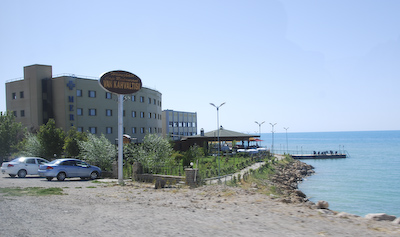 Side/Back View of the Merit Hotel From the Road
Side/Back View of the Merit Hotel From the Road
It was very late by the time we finished eating. We sat for a short while in the lobby to talk but then everyone returned to their rooms for the night. It had been a full and exhausting day.
